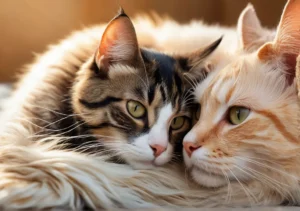Have you ever wondered why your cat sticks to you like Velcro? In this blog post, we’ll explore the reasons behind why some feline friends are more clingy than others.
Cats can exhibit velcro-like behavior for a variety of reasons, such as seeking comfort, attention, or security from their human companions. Let’s take a closer look at why your cat may be exhibiting this behavior and what you can do to understand and support their needs.
Feline Attachment Styles
Cats, just like humans, can exhibit different attachment styles towards their owners. Some cats may have a secure attachment, where they feel comfortable and confident in their relationship with their human. They are often independent but still enjoy cuddle sessions and affection.
On the other hand, some cats may display insecure attachment styles. These cats might be more aloof, skittish, or show signs of anxiety when separated from their owner. They may constantly seek reassurance and attention to feel secure in their bond.
There are also cats with ambivalent attachment styles. These cats may have a love-hate relationship with their owner, seeking attention one moment and then pushing them away the next. They can be unpredictable in their behavior, sometimes craving affection and other times preferring solitude.
Understanding your cat’s attachment style can help you meet their emotional needs and enhance your relationship with them. By recognizing their unique way of bonding, you can provide the right balance of attention and space to ensure they feel secure and loved.
Socialization and Early Experiences
A cat’s early socialization and experiences play a significant role in shaping their behavior and attachment to their human. Kittens that are properly socialized from a young age tend to be more confident, outgoing, and affectionate towards people. They are more likely to develop a secure attachment with their owner and feel comfortable in various environments.
On the other hand, kittens that have had negative experiences or lack socialization may grow up to be more fearful, shy, or even aggressive towards humans. These cats may struggle to trust and form strong bonds with their owners, leading to velcro cat behavior as a way to seek security and comfort.
As a cat owner, it’s crucial to provide your cat with positive experiences, gentle handling, and proper socialization to help them develop into well-adjusted and happy companions. By creating a safe and loving environment, you can help your cat feel secure and reduce velcro cat behavior that stems from early negative experiences.
Behavioral Issues
If your cat is constantly stuck to you like velcro, it could be due to underlying behavioral issues such as separation anxiety or fearfulness. Cats that display velcro-like behavior may be seeking comfort and security from their owner, especially if they feel anxious or stressed when left alone. It’s essential to observe your cat’s body language and behavior to determine the root cause of their clinginess. Providing a safe and calming environment for your cat can help alleviate their anxiety and reduce their need for constant contact with you.
Bonding Activities
Building a strong bond with your cat is crucial for addressing velcro-like behavior. Engaging in bonding activities can help fulfill your cat’s emotional needs and strengthen your relationship. Some bonding activities you can try include interactive play sessions, grooming your cat, or simply spending quality time together. Offering treats and positive reinforcement during these activities can also help reinforce the bond between you and your cat. Remember, consistency is key when it comes to bonding with your feline friend.
Specific Insight:
In addition to traditional bonding activities, consider incorporating puzzle toys or food-dispensing toys into your cat’s routine. These interactive toys can provide mental stimulation and encourage independent play, which may help reduce your cat’s reliance on constant physical contact with you. By engaging your cat in these activities, you can help them feel more secure and content on their own.
Medical Considerations
If your cat is suddenly clinging to you more than usual, it’s essential to rule out any medical issues first. Sometimes changes in behavior can be a sign of an underlying health problem. From pain to anxiety, a visit to the vet can help address any potential issues your furry friend may be experiencing. Once you rule out medical concerns, you can focus on other aspects of their behavior.
Creating Boundaries
Setting boundaries with your velcro cat is crucial to maintain a healthy relationship. While it’s important to provide love and attention, it’s also essential to establish limits. You can create designated areas where your cat can spend time alone, like a cozy cat tree or a comfy bed. By giving your cat space to retreat when needed, you’re helping them feel secure while respecting their boundaries. Additionally, engaging your cat in interactive play sessions can help redirect their clingy behavior in a positive way.
Tips for Creating Boundaries: 1. Designate specific play and cuddle times to establish a routine. 2. Use positive reinforcement techniques to reward independent behavior. 3. Provide stimulating toys and scratching posts to keep your cat entertained. 4. Consider implementing a feeding schedule to encourage independence. 5. Invest in puzzle feeders or treat-dispensing toys to keep your cat mentally engaged.
By balancing affection with boundaries, you can help your velcro cat feel secure and content in your home.
Seeking Professional Help
If your cat’s clingy behavior becomes excessive or suddenly changes, it may be time to seek professional help. A visit to the veterinarian can rule out any underlying health issues causing the behavior. Additionally, consulting with an animal behaviorist can help you understand your cat’s needs better and provide guidance on how to manage their clinginess effectively. Remember, professional help can be a valuable resource in addressing your velcro cat’s behavior and ensuring they lead a happy and healthy life.
Fun Facts About Velcro Cats
Velcro cats, known for their constant need for attention and companionship, are often great listeners and make excellent emotional support animals. They have a unique ability to sense their owner’s emotions and provide comfort when needed. These feline companions are known to form strong bonds with their humans and thrive on physical touch and affection. Despite their clingy nature, velcro cats are incredibly loving and loyal, making them wonderful additions to any household.
- Velcro cats are more likely to exhibit clingy behavior if they were orphaned or weaned too early.
- These cats often prefer to be in close proximity to their owners, following them from room to room.
- Velcro cats are prone to separation anxiety and may become distressed when left alone for extended periods.
Remember, understanding the reasons behind your cat’s clingy behavior can help you provide them with the care and support they need to thrive. Embracing your cat’s velcro tendencies with patience and love can strengthen your bond and create a fulfilling relationship for both of you.
Alex, a passionate animal lover, has experience in training and understanding animal behavior. As a proud pet parent to two dogs and three cats, he founded AnimalReport.net to share insights from animal experts and expand his knowledge of the animal kingdom.




